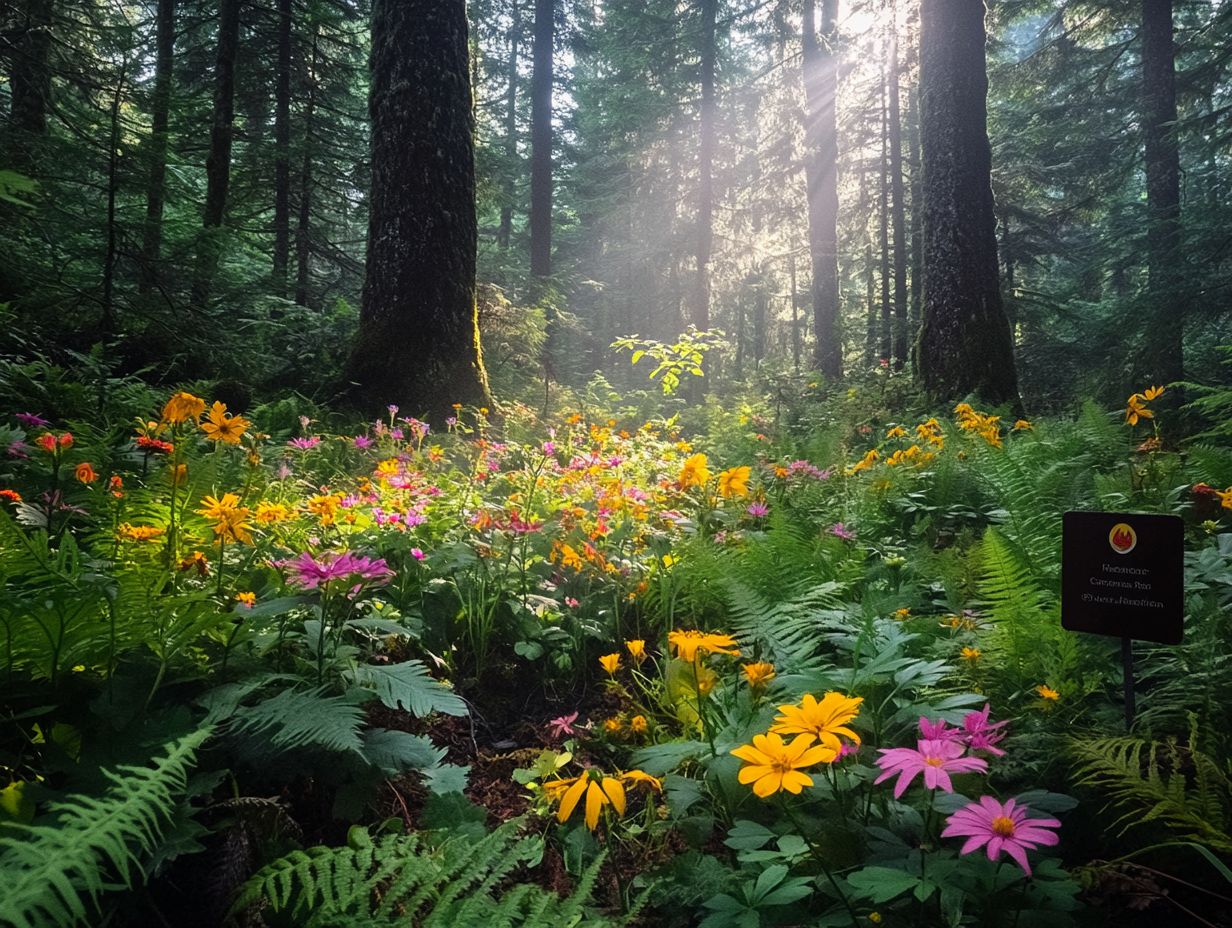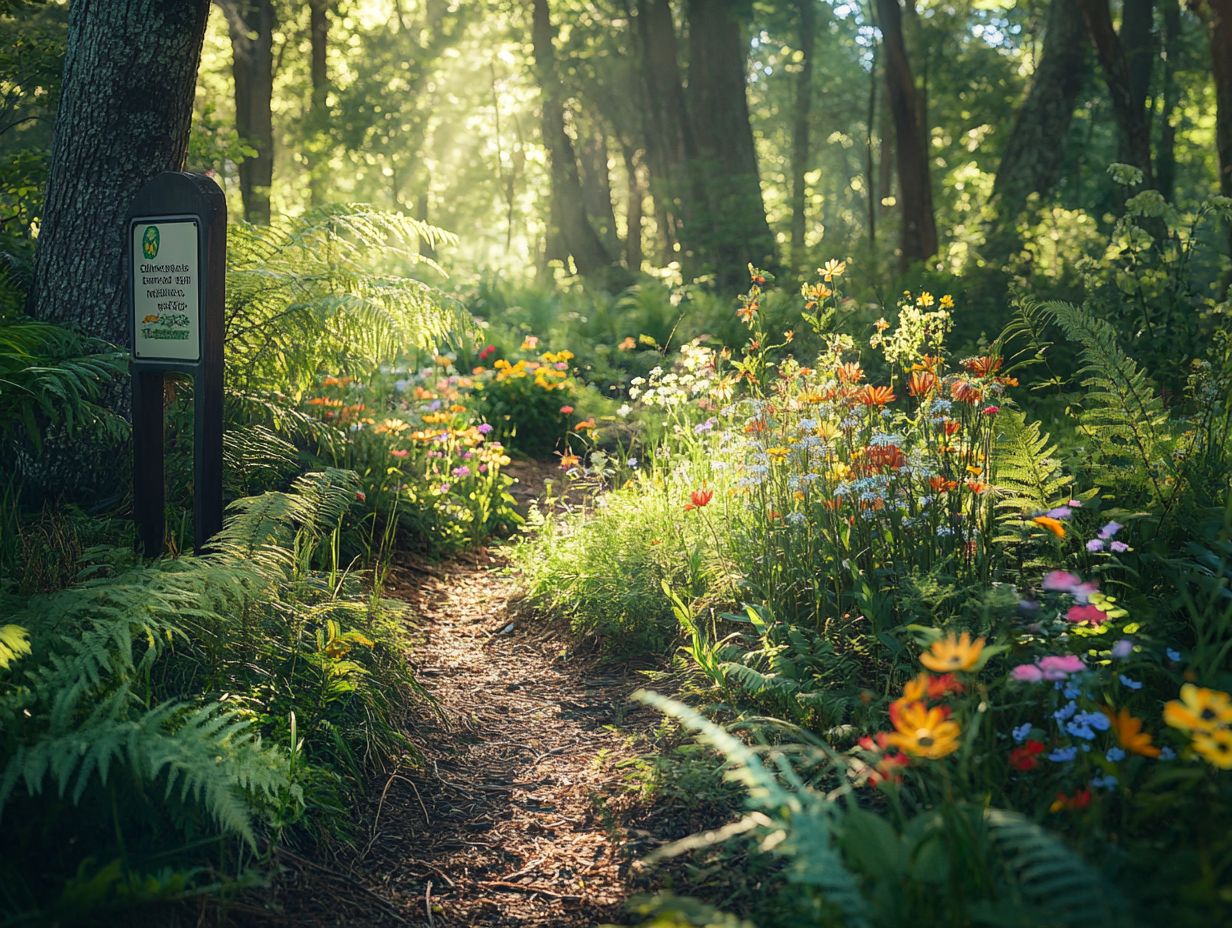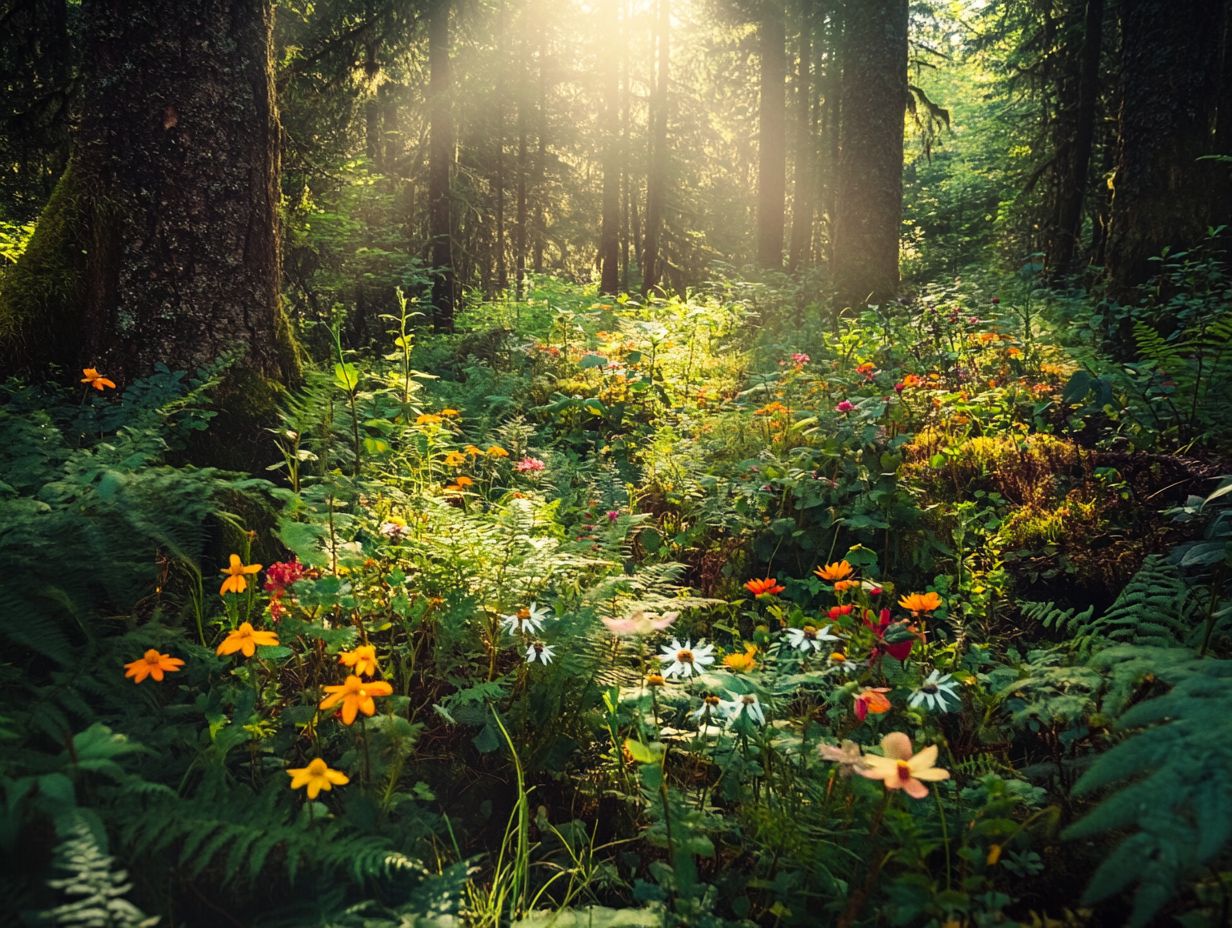How to Prevent Overharvesting of Wild Plants
Overharvesting wild plants poses a substantial threat to ecosystems and biodiversity. As the demand for natural resources intensifies, the delicate balance of nature is threatened.
This article delves into the signs of overharvesting and its root causes. You’ll discover the urgent need for preventive measures, sustainable harvesting practices, alternative cultivation techniques, and the vital role of spreading awareness to safeguard our planet’s rich flora.
Together, let’s safeguard our planet’s rich flora.
Contents
- Key Takeaways:
- The Importance of Preventing Overharvesting
- Identifying Overharvested Wild Plants
- Causes of Overharvesting
- Preventive Measures for Overharvesting
- Alternative Sources for Wild Plants
- Educating Others on Overharvesting
- Frequently Asked Questions
- What is overharvesting of wild plants?
- Why is overharvesting of wild plants a problem?
- How can I help prevent overharvesting of wild plants?
- What are some sustainable harvesting practices for wild plants?
- Can overharvesting of wild plants be regulated?
- What are the consequences of picking too many wild plants?
Key Takeaways:

- Overharvesting has negative impacts on ecosystems and biodiversity.
- Identifying signs and symptoms of overharvesting is crucial in preventing further damage.
- Human and environmental factors contribute to overharvesting, but regulations and sustainable practices can help prevent it.
The Importance of Preventing Overharvesting
Preventing overharvesting is essential for maintaining ecological balance, safeguarding the health of ecosystems, and protecting biodiversity, especially in public lands where wild and medicinal plants flourish.
If overharvesting occurs, it can result in economic setbacks for local communities and cause significant environmental harm, leading to plant extinction and the decline of endangered species.
We must embrace sustainable practices now to protect our ecosystems for future generations.
Effects on Ecosystems and Biodiversity
The effects of overharvesting on ecosystems and biodiversity can be truly devastating. It poses a significant threat to the survival of native forests and various species, including those on the endangered list.
When key species those that have a large impact on their ecosystem are removed from their habitats, it disrupts the delicate balance that sustains entire ecosystems. Take, for example, the introduction of invasive species like carp and zebra mussels; these invaders exacerbate the problem by outcompeting native species for vital resources and throwing food chains into disarray.
They not only consume essential nutrients but also alter water quality and habitat structures, creating severe ramifications for local flora and fauna. Healthy ecosystems are crucial for maintaining environmental stability, regulating climate, purifying water, and supporting a myriad of organisms that contribute to the planet’s overall biodiversity.
Understanding these connections is vital for creating a sustainable future.
Identifying Overharvested Wild Plants
Identifying overharvested wild plants is vital for protecting biodiversity and safeguarding medicinal plants and other essential species from the threat of unsustainable practices. By recognizing the signs of overharvesting, you enable conservationists to initiate effective actions that promote recovery and sustainability.
Your awareness can make a significant difference in preserving the delicate balance of our ecosystems.
Signs and Symptoms of Overharvesting
The signs and symptoms of overharvesting are unmistakable, manifesting as noticeable declines in the population numbers of wild plants and shifts in biodiversity. You might observe reduced growth rates and a lack of regeneration in frequently harvested species.
These indicators serve as urgent warnings about the declining health of ecosystems. For example, in certain regions, the relentless overharvesting of medicinal herbs leads to a decrease in specific plant populations and a shift in species composition, allowing less competitive weeds to take over.
As these changes unfold, habitat health can deteriorate. When plant cover diminishes, soil erosion can increase, further eroding biodiversity and degrading the entire ecosystem.
The disappearance of keystone species sends ripple effects throughout the food web, disrupting interactions among flora and fauna and destabilizing the environment even more.
By understanding these symptoms, you can play a crucial role in guiding conservation efforts aimed at restoring balance and protecting vulnerable habitats.
Causes of Overharvesting

Understanding the causes of overharvesting is vital for creating effective conservation strategies. Economic pressures and rising demand for wild resources, along with climate change and invasive species, are significant factors in this urgent issue.
By grasping these complexities, you can better contribute to meaningful solutions.
Human Factors and Environmental Factors
Human factors that contribute to overharvesting include population growth, economic pressures, and soaring demand for resources. Environmental challenges like climate change and invasive species further complicate the situation.
Your quest for resources, driven by a growing population, places immense strain on ecosystems. As communities work to meet their basic needs, practices such as overfishing and deforestation have become alarmingly common. This leads to the depletion of vital habitats.
Invasive species disrupt local ecosystems, upsetting the delicate balance of biodiversity. These intertwined human and environmental dynamics create a harmful cycle that threatens the stability of various species and the overall health of ecosystems.
We must act now to use our resources sustainably, especially in the context of public lands, to safeguard biodiversity for future generations.
Preventive Measures for Overharvesting
Implementing preventive measures against overharvesting is crucial for the long-term preservation of biodiversity and ecosystem health. This involves establishing strong rules and promoting eco-friendly methods that limit resource extraction and encourage responsible stewardship of public lands.
By taking these steps, you significantly contribute to the protection of our natural heritage, including endangered species and the restoration of ecosystem health for future generations.
Regulations and Sustainable Harvesting Practices
Regulations on harvesting wild plants and adopting sustainable practices are essential for combatting overharvesting and ensuring the protection of biodiversity and ecological health. These measures maintain ecological balance and support local economies that depend on invaluable natural resources.
Various countries have instituted stringent guidelines to monitor and regulate resource extraction, ensuring that practices align with ecological standards. For example, the Convention on International Trade in Endangered Species (CITES) plays a pivotal role in controlling trade in endangered species, effectively curbing illegal harvesting.
Successful case studies, like community-managed forest initiatives in Brazil, demonstrate how regulatory frameworks empower local stakeholders and enhance conservation efforts. The role of regulatory bodies is critical; they enforce compliance, educate communities, and foster collaboration between governments and local organizations to safeguard natural resources for future generations.
Alternative Sources for Wild Plants
Exploring alternative sources for wild plants through cultivation, such as agroforestry and innovative farming techniques, can significantly relieve pressure on natural populations. This proactive approach not only aids in preserving ecosystems but also fosters a more sustainable relationship with our environment.
Cultivation and Farming Techniques

Cultivating and employing farming techniques for wild plants, like growing trees alongside crops and livestock and controlled harvesting, present sustainable alternatives that meet human demands while helping preserve biodiversity.
These approaches also strengthen ecosystem health and foster resilient agricultural systems that can adapt to shifting environmental conditions. For instance, agroforestry seamlessly blends tree cultivation with crop and livestock farming, enhancing soil quality, reducing erosion, and creating habitats for various species.
Controlled harvesting, on the other hand, allows for the sustainable extraction of resources without depleting populations. Communities have effectively managed the harvesting of wild medicinal plants to demonstrate this practice.
Both practices are crucial for biodiversity conservation, ensuring ecosystems remain vigorous and capable of supporting a rich diversity of flora and fauna, even amid the pressures of agriculture and invasive species.
Educating Others on Overharvesting
Educating others about overharvesting is vital for cultivating public awareness and advancing conservation efforts. By doing so, you play a critical role in protecting biodiversity and ensuring the vitality of healthy ecosystems.
Spreading Awareness and Promoting Conservation Efforts
Spreading awareness about overharvesting and its impacts, such as the threat posed by invasive rodents and the need for sustainable practices, is essential for mobilizing communities and fostering conservation efforts that protect biodiversity on public lands.
Participating in interactive workshops and engaging in discussions offers insight into sustainable practices and the long-term consequences of resource depletion. Leveraging social media platforms expands your reach, using captivating visuals and informative content to grab attention and spark meaningful conversations about this pressing issue.
Collaborating with local organizations strengthens these initiatives, creating a united front that can influence policy changes and inspire grassroots movements, particularly for protecting endangered species and enhancing ecosystem health. Ultimately, public awareness forms the backbone of these efforts, nurturing community engagement that is essential for achieving meaningful and lasting change in the preservation of natural habitats.
Frequently Asked Questions
What is overharvesting of wild plants?
Overharvesting of wild plants refers to the excessive collection or harvesting of plants from their natural habitats, leading to depletion of their populations and potential plant extinction.
Why is overharvesting of wild plants a problem?

Overharvesting can disrupt the natural balance, reduce biodiversity, and affect the food chain, ultimately contributing to environmental harm.
How can I help prevent overharvesting of wild plants?
You can help prevent overharvesting by avoiding the consumption of wild plants unless you are sure they were sustainably harvested. Support local and sustainable harvesting practices, and advocate for conservation efforts that protect our native forests and public lands.
What are some sustainable harvesting practices for wild plants?
Sustainable harvesting practices include leaving enough plants behind for natural regrowth, rotating harvesting locations, and using non-destructive methods like handpicking instead of uprooting, which is vital for maintaining ecosystem health.
Can overharvesting of wild plants be regulated?
Yes, overharvesting can be regulated through laws that set limits on the amount that can be harvested, require permits, and establish protected areas for plant populations to recover, ensuring the safeguarding of our freshwater ecosystems.
What are the consequences of picking too many wild plants?
Picking too many wild plants can lead to the decline or extinction of plant species. This also harms the habitats of other species and disrupts cultural practices that depend on these plants.
For example, invasive species like bighead carp and zebra mussels can thrive in disrupted ecosystems, further complicating the issue. Protecting our wild plants is crucial for maintaining biodiversity and cultural heritage.






